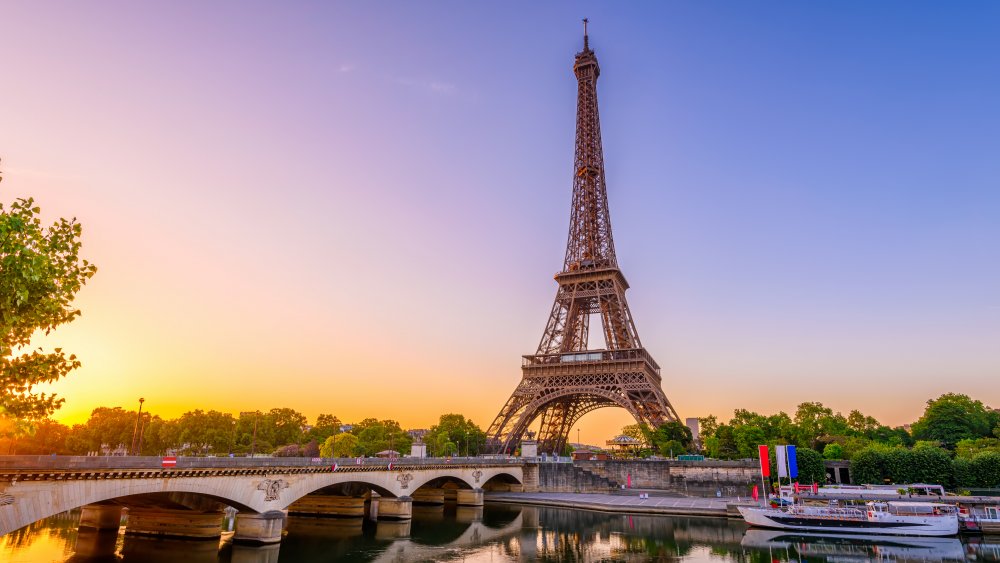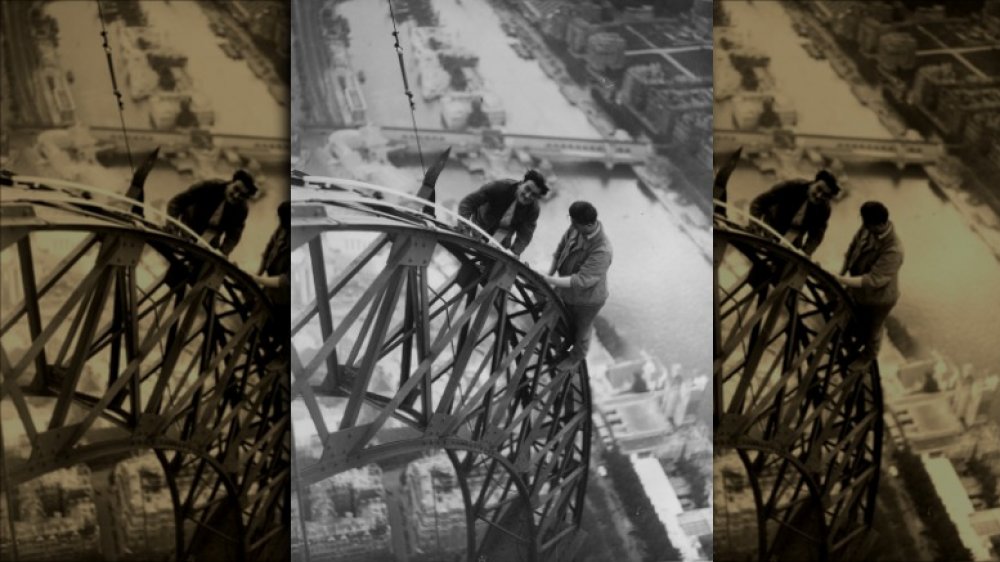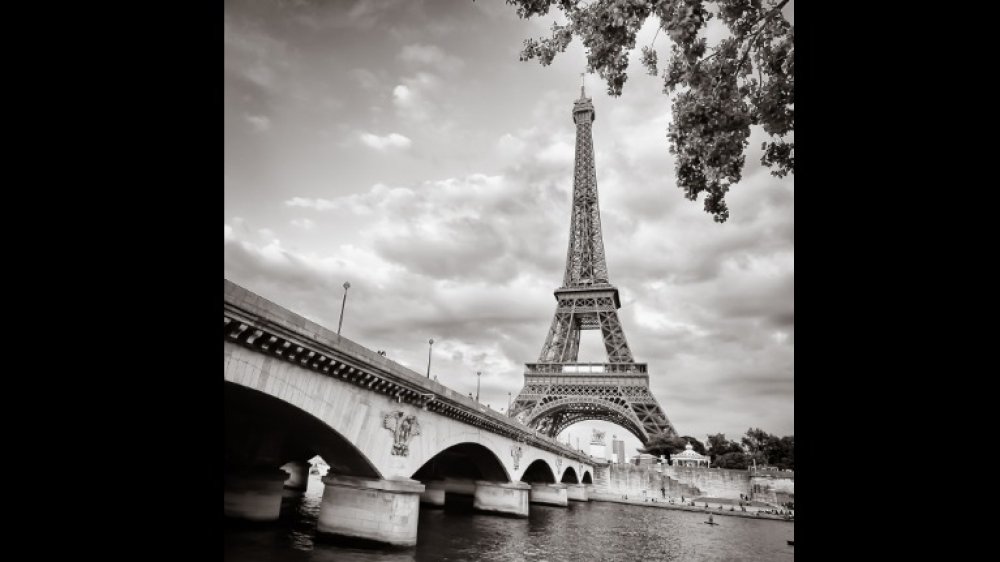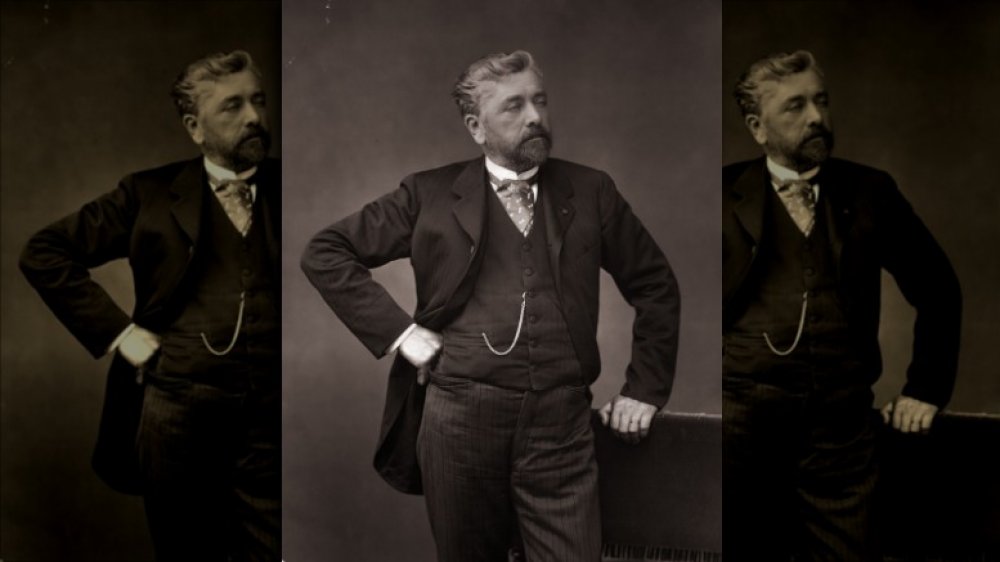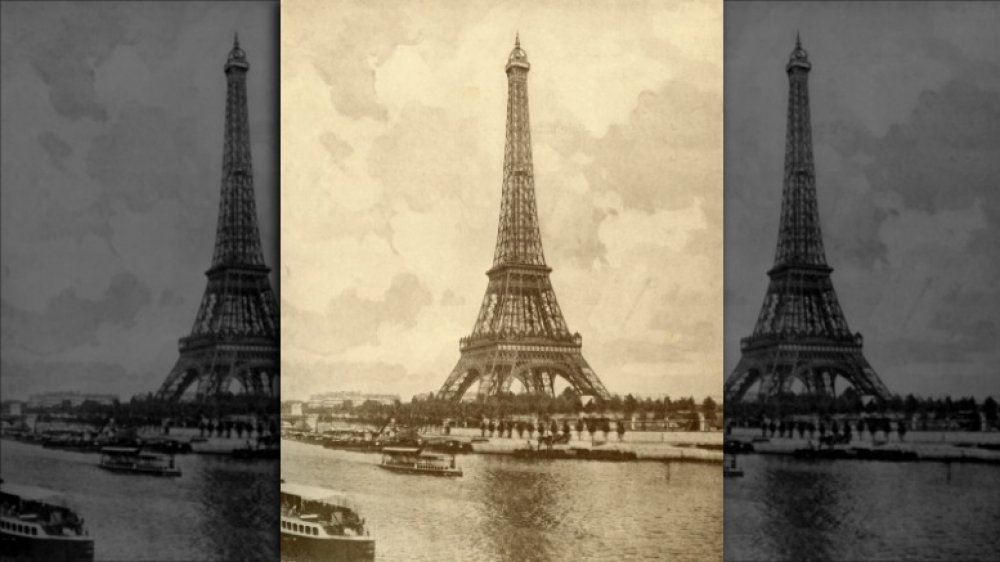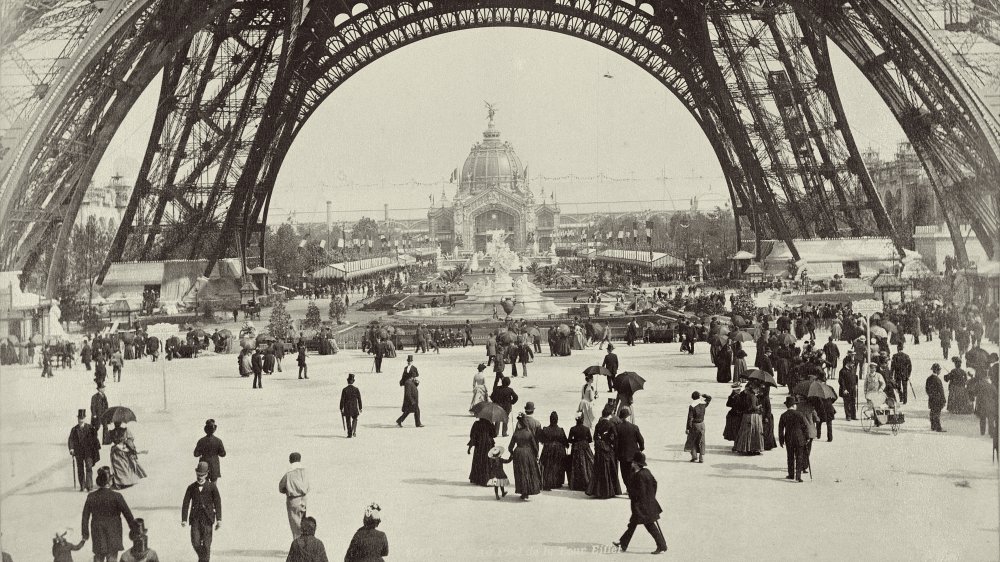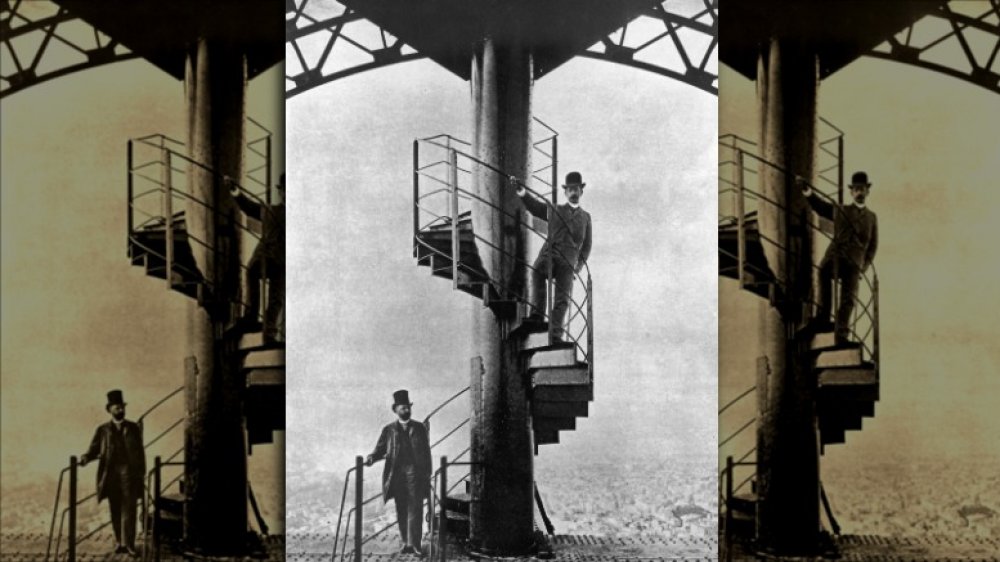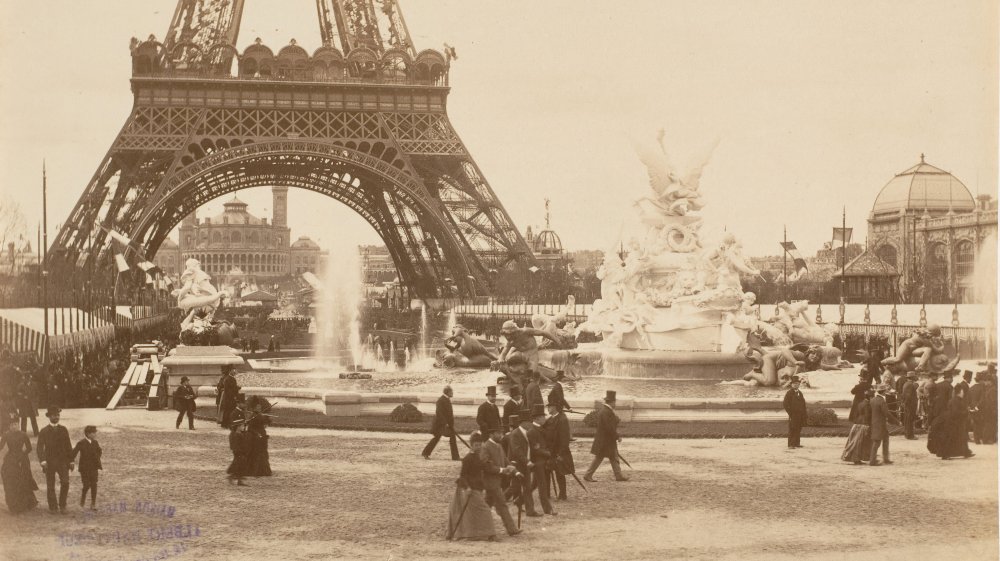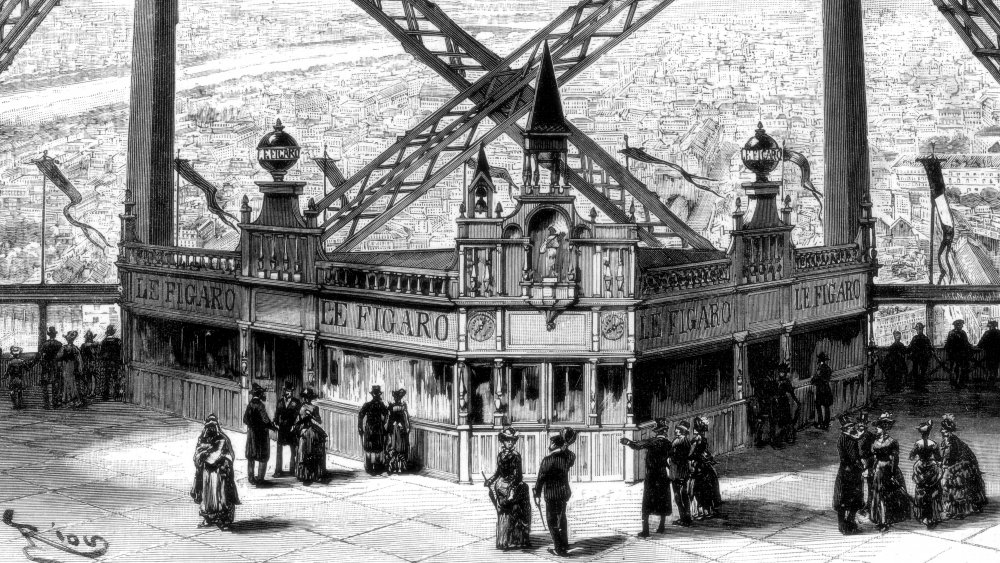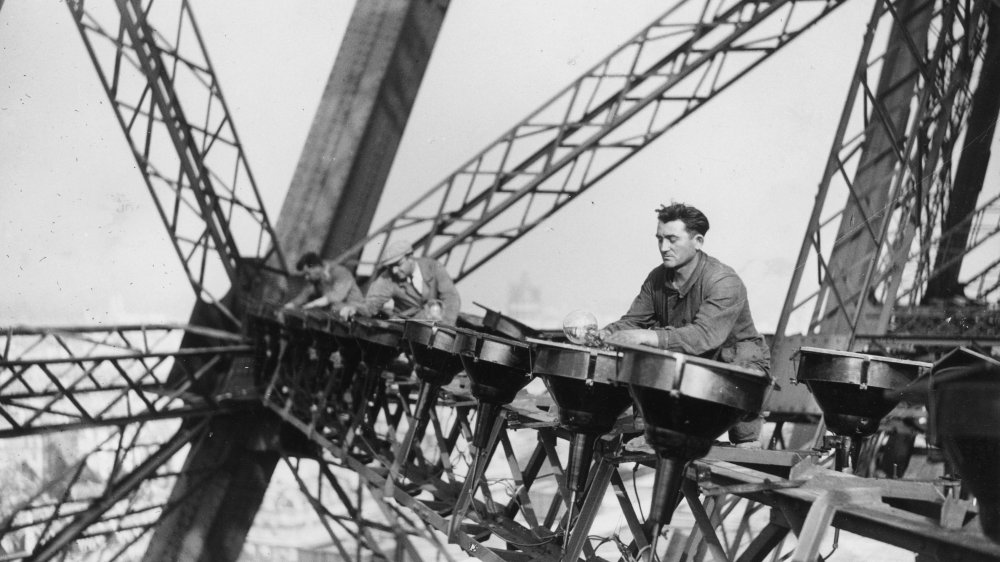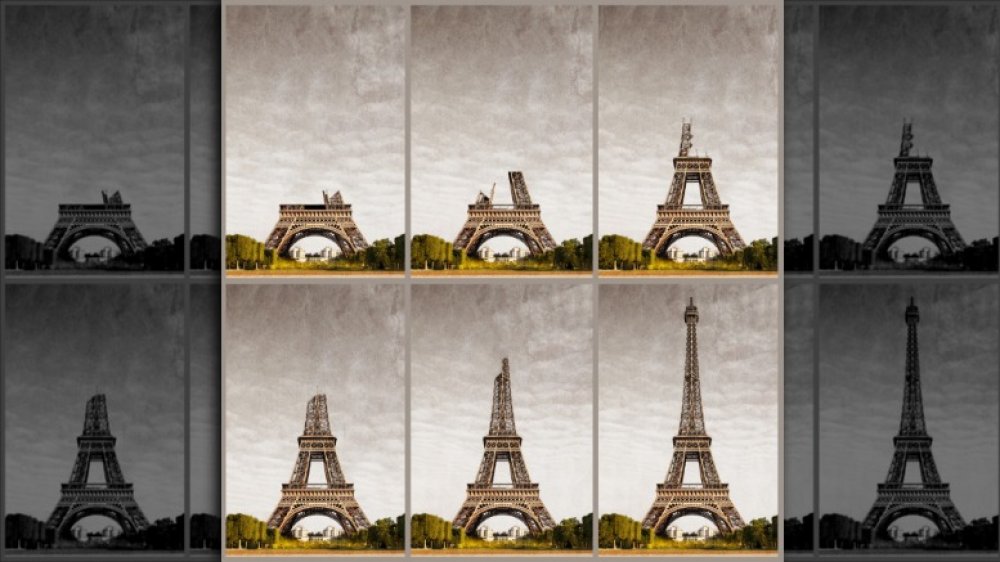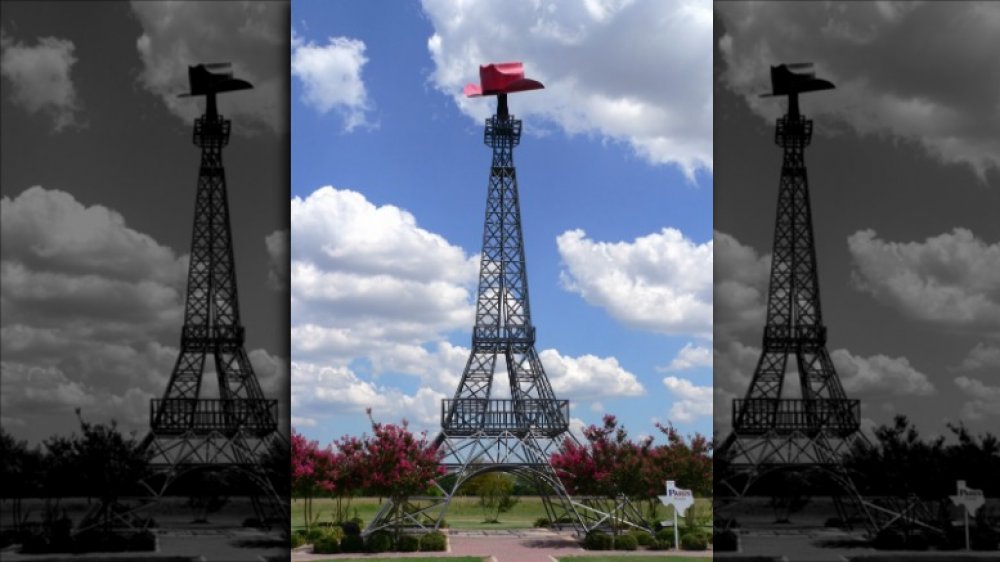The Bizarre History Of The Eiffel Tower
Ah, Paris ... the most romantic city on earth. France has been a center of culture, fashion, art, and more for centuries, and Paris, its capital, has drawn in those who wish to experience all France has to offer. But did you know that one of its most iconic landmarks, the Eiffel Tower, was originally built specifically to do that? Unlike many monuments, which were crafted to commemorate world leaders, mark a military victory, or even memorialize a grudge, the Eiffel Tower was designed from the get-go to bring in those sweet, sweet tourist francs.
As the Encyclopedia Britannica points out, the International Exposition, or Exposition Universelle, of 1889 served a dual purpose: To mark the 100th anniversary of the French Revolution and to highlight French prowess in art, architecture, engineering, and pretty much any human endeavor that made the French look good.
Part of that involved commissioning a freakishly massive structure to stand at the heart of it all — a 300-meter (984-foot) "spike." This would eventually emerge as the Eiffel Tower we know and love.
The Eiffel Tower is a marvel of modern engineering
A centerpiece of the 1889 Paris International Exposition, the Eiffel Tower is an engineering marvel. At the time, few people even thought it could be built, as the Encyclopedia Britannica highlights, it was twice as high as the Great Pyramid of Giza. It would remain the world's tallest man-made structure until New York's Chrysler Building was completed in 1929, holding the record for four decades.
But steelwork and engineering were developing rapidly in the late 1880s, and the exposition's planners were sure that someone could make a 300-meter steel tower. As an article in World's Fair notes, several engineers and architects had previously drawn up plans for monumental structures that would theoretically rise even higher, and the Statue of Liberty hadn't crashed under its own weight in the three years it had been standing.
And so the Eiffel Tower was commissioned. It took between 150 and 300 workers only 26 months to assemble it from 18,000 pieces, mostly constructed offsite and moved into place like prefab houses today, according to the Tour Eiffel official history. Once on the site, teams of four would join everything together with rivets — more than 2,500,000 of them, all told. As the tower grew, the workers added wooden scaffolds and even miniature steam cranes to be able to reach the next construction level, literally innovating building techniques as they went, as Travel and Leisure notes.
The Eiffel Tower was the result of a design competition
The graceful spike with the arched base wasn't always the plan. Before it was the Eiffel Tower, the Paris Exposition monument was ... a design contest. That's right, one of the world's most iconic structures was crowdsourced. According to scholar Arthur Chandler, in preparation for the 1889 exposition, wanting to celebrate the communal spirit of the French Revolution, the city of Paris put out a call for design entries for the centerpiece spike.
As Philippe Bouin and Christian-Philippe Chanut note in their Histoire française des foires et des expositions universelles, there were more than 700 entries, whittled down to 107 feasible ones. Eventually, Gustave Eiffel's proposal was chosen. Though not before some serious name-calling and fighting among the finalists, as the Wall Street Journal recounts. According to Tour Eiffel, mastermind Eiffel won out on the basis of his engineering experience and his low bid — he claimed he'd be able to finish the monument in record time at a record low cost. And, as LiveScience relates, he pulled it off. The structure cost only about $1.5 million and took a mind-boggling fast two years, two months, and five days to go from submission to completion.
Yet the "odious column of metal," as it was called, wasn't the weirdest proposal for the exposition's central monument. As the Telegraph notes, some of the entries included things like a giant watering can and a 300-meter-tall guillotine.
Gustave Eiffel didn't design the Eiffel Tower
The guy whose name is on the dang thing didn't actually design the Eiffel Tower. Instead, as Arthur Chandler notes in World's Fair, Gustave Eiffel purchased the design for the iconic structure from two junior members of his engineering firm, Maurice Koechlin and Émile Nouguier.
According to History.com, Koechlin had proven himself as both a visionary and a details guy years earlier, when he helped with the creation of the steel skeleton supporting the Statue of Liberty, also executed under Eiffel's watch. The guy had a knack for drafting crazy tall steel structures that actually worked, and Eiffel knew the Exposition design competition was coming up. When Koechlin and Nouguier presented their boss with a plan for an exposed steel column rising from the points of the compass, he knew they were on to a great way to highlight his company's skill with steel — and win more future contracts on lucrative projects like bridges.
Ever the savvy businessman, as Tour Eiffel points out, Eiffel quickly bought the rights to the plans so that there would be no question of who got the credit. He then hired architect Stephen Sauvestre to pretty the whole thing up, as Paris Invisible recounts. From there, it was a small matter of knowing the right folks and getting that sweet construction contract, as World's Fair relates.
Some of the Eiffel Tower was built underwater
The location for the Eiffel Tower was, shall we say, not ideal. The Champ de Mars park and garden, while beautiful and centrally located, also happens to butt right up against the River Seine. So while Eiffel's workers could manage several of the foundations using familiar, if upgraded, techniques, the river had to be dealt with using some pretty advanced engineering.
On the Seine River side of the tower, the footings had to be installed below water level. So as Tour Eiffel points out, the engineering firm built air-tight capsules and workers went underwater, relying on compressed air to stay alive and breathing as they riveted. By this point, caisson technology, as it was called, had only been around for a few decades at best, as engineer William Nuttle notes. The South Australian Medical Heritage Society points out that working inside a pressurized caisson was stupidly dangerous — not only were they prone to popping leaks, but incorrect pressure could make your actual eyeballs burst while ascending or descending too quickly could give you a fatal case of the bends.
Nonetheless, as Study.com highlights, only a single worker died building the tower — Eiffel's safety protocols were as innovative and rigorous as his engineering standards.
People hated the Eiffel Tower at first
While the Eiffel Tower is a beloved icon today, when it was first proposed and built, people friggin' hated it. Even after acclaimed architect Stephen Sauvestre massaged the original design to add sweeping arches, ornate latticework, and pretty glass accents, the artistic elite almost universally despised Eiffel's winning plans. Tour Eiffel admits that the criticism started even before construction did, with one of Eiffel's competitors deriding the whole thing as "vulgar." Writing in World's Fair, Arthur Chandler relates that one of the other finalists, who'd proposed a massive stone column, felt that Eiffel's latticed steel structure was unfinished.
Worse, a who's-who of artistic celebrities of the time, including authors Guy de Maupassant and Alexandre Dumas Junior, wrote a scathing letter published in Le Temps newspaper, as History.com points out. More than 300 artists pled for the Exposition organizers to choose something — anything! — other than this "gigantic black factory chimney" to represent their city and their work as artists.
That started a vicious cycle of name-calling, finger-pointing, and flat-out brawling between Eiffel and other industrial proponents and the bohemian artists and cultural celebrities of Paris. As Vox details, the back-and-forth of bitter newspaper editorials, open letters, posters, and more looked suspiciously similar to social media campaigns and cancel culture today.
The Eiffel Tower wasn't quite finished when it opened
Because the tower had to be done in time for the opening of the Paris exposition, the builders were on a tight schedule. As Tour Eiffel notes, they only broke ground in January 1887, and the whole thing was scheduled to open to the public on May 6, 1889. Working on a never-before-seen scale, with unproven techniques and a limited budget, with relatively rudimentary equipment, Eiffel and his engineering firm somehow pulled it off: The tower was ready to go on March 31, 1889.
Well, kind of. A number of features weren't done when visitors first started flocking to the new landmark. For example, the elevators — which had to be custom-built to cope with the angled structure, as a technical paper notes — weren't working. So visitors had to climb the whopping 1,710 steps to get to the top, as LiveScience relates.
Well, again -—kind of. Tourists were only able to get to the second viewing platform when the tower opened, as History.com relates. While the view from 377 feet up, as Tour Eiffel points out, was no doubt spectacular, especially to folks who had never been more than five or six stories high, it was nothing compared to the full experience at 906 feet. No wonder some visitors made repeat trips, even at a cost of 5 francs a go — well more than a nice dinner out at the time, according to Tour Eiffel. There was reportedly a record of 400,000 visitors in a single day, and by the end of the year and exposition, almost two million people had ascended the Eiffel Tower.
The Eiffel Tower was supposed to be temporary
Despite all the money and engineering prowess lavished on its construction, the Eiffel Tower was never meant to last, according to Archetizer. As part of the International Exposition, it was only intended to briefly drum up acclaim for French innovation.
In fact, its existence was only guaranteed for 20 years. Knowing that the Exposition organizers were cheapskates and expected him to bear 80% of the cost of the tower's construction, as World's Fair notes, Eiffel negotiated for exclusive rights to all proceeds from the tower for 20 years. Yes, he had to invest a small fortune into building the thing, but he made it back in less than a year — and went on to become filthy rich from ticket sales, restaurant concessions, and more.
When the 20 years were up, rights reverted to the city of Paris, which was widely expected to tear it down. That led to one of the stranger episodes in a pretty strange existence: a con man managed to sell the Eiffel Tower for scrap. Twice.
According to Smithsonian, Victor Lustig got the idea to travel to Paris and pretend to be a French government official. He invited bids from prominent scrap dealers, warning that they'd have to demolish the dang thing if they wanted all 7,300 tons of steel. They bit, and Lustig managed to con not one, but two, dealers into forking over wads of cash, as Mental Floss relates.
The Eiffel Tower has had a bunch of uses
In addition to being one of the world's most visited tourist attractions, the Eiffel Tower has had a huge variety of other uses over the years — some of them kind of bizarre.
The various restaurants at the base and on the viewing platforms seem normal enough. What tourist trap doesn't have an overpriced restaurant or two attached? But Gustave Eiffel had the original plans revised to include an apartment at the top, as Architectural Digest relates.
Headed in the other direction, one of the legs of the tower houses a not-exactly-secret entrance to an underground military bunker, as CNet describes. And that resemblance to a radio tower? Not a coincidence. The Eiffel Tower was used to broadcast radio signals, including military transmissions, around 1909, as History.com notes.
Oh, and for nine years, starting in 1925, the Eiffel Tower was the world's biggest billboard. French automaker Citroen bought the rights to stick 250,000 light bulbs spelling its name onto the monument, lighting up the skies of Paris with one heck of a suggestion to buy local, as Autocar notes.
The Eiffel Tower requires some serious maintenance
Building a 300-meter landmark isn't a set-it-and-forget-it thing. It takes a lot of work to keep the tower upright and in good shape to greet its hundreds of thousands of visitors. According to Tour Eiffel, every seven years, more than 60 tons of paint has to be applied ... which takes 25 guys working by hand the same way they did in 1889. Yes, with little paintbrushes. They don't even get rollers or spray guns. As Corrosion Doctors notes, the only thing that's really changed is the formulation of the paint, which is now more eco-friendly. The color also changes every few decades, according to Tour Eiffel. The original reddish tone was switched up to yellow early on, as History.com points out. Today it's a neutral bronze, slightly lighter at the top to make sure it stands out well against the Parisian sky.
But giving the monument a paint job every few years isn't all that's required to keep the Eiffel Tower looking good. The ongoing cleaning is a beast, requiring 25,000 garbage bags and 105 gallons of cleaning solution and wipes, as National Geographic details.
The Eiffel Tower grows, shrinks, and moves
You'd think a massive iron spike would be, you know, fixed in place. But in order to deal with high winds, changing weather, and even an unplanned earthquake, the Eiffel Tower can actually move and flex. As LiveScience relates, the heat of the sun can cause the structure to swell and bend, swaying like a sunflower by up to 7 inches. The wind, too, causes the structure to move by two or three inches. Tour Eiffel points out that Gustave Eiffel was one of the most innovative engineers of his day and was basically a wizard with steel. He made sure that all elements of the design would work with wind forces appropriately, rather than making the structure buckle or creating mini-cyclones that would endanger pedestrians or other buildings.
As the Telegraph points out, the cold also influences the structure. The Eiffel Tower shrinks by up to 6 inches in winter as cold temperatures cause the steel to contract. Yet those sturdy foundations laid more than 100 years ago are still holding firm, according to Tour Eiffel, and most visitors never even feel the slight wobble from wind and sun.
The Eiffel Tower has been copied a whole bunch
There's no getting around the fact that the Eiffel Tower is an icon — and one of the world's most visited destinations. The almost two million visitors who viewed the Eiffel Tower in its first year of existence back in 1889 were only the beginning: according to CNN, nearly seven million people visit each year. That's almost 300 million visitors since its opening.
But while there's only one original, everyone seems to want to experience the Eiffel Tower — even if they can't get to Paris. There are replica Eiffel Towers all over the world, in various scales. From the Eiffel Tower Experience at Paris Las Vegas to copies in China, Greece, and Paris (Texas, that is), if you want to catch some tourists, apparently all you have to do is put up a mini Eiffel Tower. Architectural Digest rounded up a list of the top 16 replicas, though there are 50 worldwide and counting. One of the most famous is probably the one in Paris, Texas, which stands 60 feet tall and, as Atlas Obscura notes, wears its own screaming red cowboy hat.
You won't see that in France.
